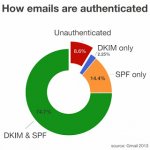David Baxter PhD
Late Founder
Internet-wide efforts to fight email phishing are working
by Elie Bursztein, Google Online Security Blog
December 6, 2013
Since 2004, industry groups and standards bodies have been working on developing and deploying email authentication standards to prevent email impersonation. At its core, email authentication standardizes how an email?s sending and receiving domains can exchange information to authenticate that the email came from the rightful sender.
Now, nearly a decade later, adoption of these standards is widespread across the industry, dramatically reducing spammers? ability to impersonate domains that users trust, and making email phishing less effective. 91.4% of non-spam emails sent to Gmail users come from authenticated senders, which helps Gmail filter billions of impersonating email messages a year from entering our users? inboxes.
More specifically, the 91.4% of the authenticated non-spam emails sent to Gmail users come from senders that have adopted one or more of the following email authentication standards: DKIM (DomainKey Identified Email) or SPF (Sender Policy Framework).

Here are some statistics that illustrate the scale of what we?re seeing:
Join the fight against email spam
As more domains implement authentication, phishers are forced to target domains that are not yet protected. If you own a domain that sends email, the most effective action you can take to help us and prevent spammers from impersonating your domain is to set up DKIM, SPF and DMARC. Check our help pages on DKIM, SPF, DMARC to get started.
When using DKIM, please make sure that your public key is at least 1024 bits, so that attackers can?t crack it and impersonate your domain. The use of weak cryptographic keys -- ones that are 512 bits or less -- is one of the major sources of DKIM configuration errors (21%).
If you own domains that are never used to send email, you can still help prevent abuse. All you need to do is create a DMARC policy that describes your domain as a non-sender. Adding a ?reject? policy for these domains ensures that no emails impersonating you will ever reach Gmail users? inboxes.
While the fight against spammers is far from over, it?s nevertheless encouraging to see that community efforts are paying off. Gmail has been an early adopter of these standards and we remain a strong advocate of email authentication. We hope that publishing these results will inspire more domain owners to adopt the standards that protect them from impersonation and help keep email inboxes safe and clean.
by Elie Bursztein, Google Online Security Blog
December 6, 2013
Since 2004, industry groups and standards bodies have been working on developing and deploying email authentication standards to prevent email impersonation. At its core, email authentication standardizes how an email?s sending and receiving domains can exchange information to authenticate that the email came from the rightful sender.
Now, nearly a decade later, adoption of these standards is widespread across the industry, dramatically reducing spammers? ability to impersonate domains that users trust, and making email phishing less effective. 91.4% of non-spam emails sent to Gmail users come from authenticated senders, which helps Gmail filter billions of impersonating email messages a year from entering our users? inboxes.
More specifically, the 91.4% of the authenticated non-spam emails sent to Gmail users come from senders that have adopted one or more of the following email authentication standards: DKIM (DomainKey Identified Email) or SPF (Sender Policy Framework).

Here are some statistics that illustrate the scale of what we?re seeing:
- 76.9% of the emails we received are signed according to the (DKIM) standard. Over half a million domains (weekly active) have adopted this standard.
- 89.1% of incoming email we receive comes from SMTP servers that are authenticated using the SPF standard. Over 3.5 million domains (weekly active) have adopted the SPF standard.
- 74.7% of incoming email we receive is protected by both the DKIM and SPF standards.
- Over 80,000 domains have deployed domain-wide policies that allow us to reject hundreds of millions of unauthenticated emails every week via the DMARC standard.
Join the fight against email spam
As more domains implement authentication, phishers are forced to target domains that are not yet protected. If you own a domain that sends email, the most effective action you can take to help us and prevent spammers from impersonating your domain is to set up DKIM, SPF and DMARC. Check our help pages on DKIM, SPF, DMARC to get started.
When using DKIM, please make sure that your public key is at least 1024 bits, so that attackers can?t crack it and impersonate your domain. The use of weak cryptographic keys -- ones that are 512 bits or less -- is one of the major sources of DKIM configuration errors (21%).
If you own domains that are never used to send email, you can still help prevent abuse. All you need to do is create a DMARC policy that describes your domain as a non-sender. Adding a ?reject? policy for these domains ensures that no emails impersonating you will ever reach Gmail users? inboxes.
While the fight against spammers is far from over, it?s nevertheless encouraging to see that community efforts are paying off. Gmail has been an early adopter of these standards and we remain a strong advocate of email authentication. We hope that publishing these results will inspire more domain owners to adopt the standards that protect them from impersonation and help keep email inboxes safe and clean.
